Spektr-RG lifts off (original) (raw)
Proton sends Spektr-RG into deep space
After two delays from June 21 and July 12, the Proton rocket lifted off with the Spektr-RG astrophysics observatory on July 13, 2019. In following two hours, the Block DM-03 upper stage successfully sent the spacecraft toward the L2 Lagrange point in the Earth-Sun system, the first Russian or Soviet mission to do so.
Previous chapter: Spektr-RG's previous launch attempts
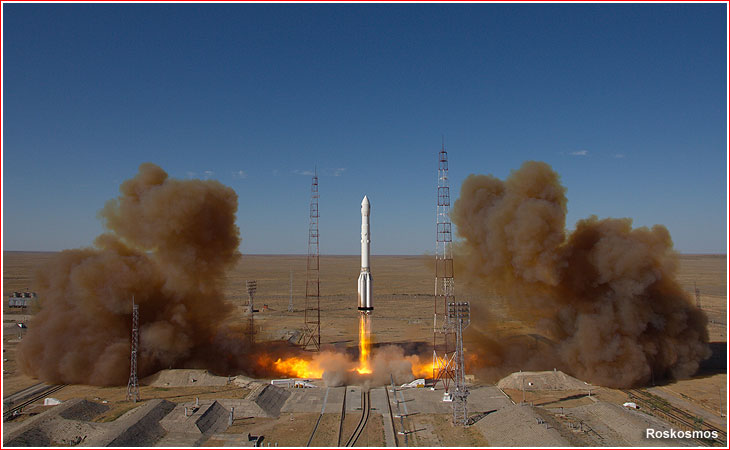
Third launch window for the Spektr-RG mission on July 13, 2019, at a glance:
| Launch date and time | 2019 July 13, 15:30:56.955 Moscow Time (actual); 15:30:57 (planned) |
|---|---|
| Launch vehicle system (RKN) | 372KN21 No. 61514 |
| Launch vehicle | Proton-M Series No. 53547, Phase 1 No. 4924837975 |
| Upper stage | Block DM-03 (11S861-03) Phase 1, Mod 1, No. 4L |
| Payload fairing | 813GLN34 Series No. 61514 |
| Launch site | Baikonur Cosmodrome, Site 81, Pad 24 |
| Spacecraft liftoff mass | *2,704 kilograms |
| Payload section mass after separation from Stage III | 23,613 kilograms |
| Launch vehicle liftoff mass | 704,684 kilograms |
| Launch vehicle length | 57,240 millimeters |
| Payload section length | 14,900 millimeters |
| Payload fairing length | 10,000 millimeters |
| External diameter of payload fairing | 4,350 millimeters |
*Based on actual measurements at the launch site before the first launch attempt. The maximum projected mass is 2,747 kilograms
Launch scenario for the Spektr-RG mission
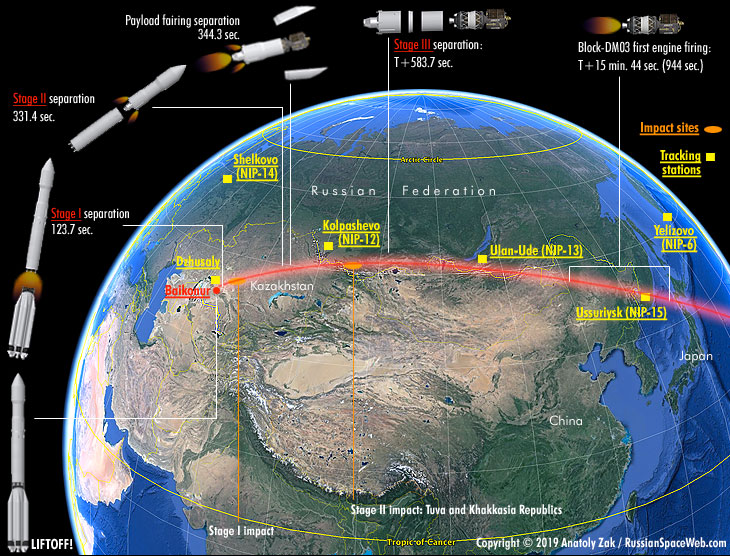
The launch sequence and ground track during the booster phase of the Spektr-RG launch.
Launch sequence according to Roskosmos:
| | Event | Elapsed time | | | ----------------------------------------------------------------------------------------------------- | ---------------- | - | | - | Liftoff | 0 | | | Stage II main engine ignition | 119.4 seconds | | | | Stage I engine cuttoff, Stage I and II separation | 123.7 seconds | | | | Stage III steering engine ignition | 327 seconds | | | | Stage II engine cutoff | 330.7 seconds | | | | Separation of Stage II from Stage III | 331.4 seconds | | | | Stage III main engine ignition | 333.8 seconds | | | | Payload fairing separation | 344.3 seconds | | | | Stage III main engine cutoff (PK) | 571.8 seconds | | | | Stage III steering engine cutoff; separation Stage III and payload section | 583.7 seconds | |
The third liftoff attempt of the Proton-M/Block DM-03 rocket, carrying the Spektr-RG satellite, was scheduled at 15:30:57 Moscow Time (12:30 UTC, 8:30 a.m. EDT) from Pad 24 at Site 81 in Baikonur Cosmodrome.
Probably because the mission targeted the L2 Lagrange point relative to the Sun, requiring the spacecraft to escape the initial parking orbit around the Earth at a certain geocentric position, while also keeping it within view of the Russian ground stations, the three-week delay of the launch from June 21 to July 13 shifted the liftoff time by 14 minutes to compensate for the movement of the Earth around the Sun.
According to the official information released before the first launch attempt on June 21, during the initial phase of the powered flight, the three booster stages of the Proton rocket will follow a standard flight path to match an orbit with an inclination 51.51 degrees toward the Equator.
The separation of the first stage took place slightly more than two minutes into the flight. The spent booster was projected to fall in the Karaganda Region in Kazakhstan. Moments before separation, the four-engine cluster of the second stage took over the powered flight, initially firing through a lattice structure connecting two stages.
At 5 minutes and 27 seconds in flight, the four nozzles of the steering engine on the third stage began to fire through openings in the upper adapter of the second stage connecting it to the third stage above. It ensured uninterrupted acceleration of the vehicle during the ignition of the main engine on the third stage just four seconds later.
After operating for around four minutes and less than six minutes into the flight, the second stage separated and then descended and crashed near the border of the Tuva and Khakassia Republics of the Russian Federation.
The main engine of the third stage ignited slightly more than two seconds after the separation and took over the powered ascent. Less than 11 seconds later, the payload fairing protecting the spacecraft from aerodynamic loads in the lower atmosphere split into two halves and dropped away. Both fragments were expected to fall in the same drop zone as the second stage.
The third stage fired its main RD-0213 engine and four steering thrusters until around 9.5 minutes into the flight. The four-nozzle steering engine continued operating for an additional 12 seconds after the main engine cutoff command to refine the velocity of the vehicle to an exact parameter. The payload section, including the Block DM-03 upper stage and the Spektr-RG satellite, separated from the third stage 9 minutes and 43 seconds after liftoff.
Planned orbital parameters at the separation of the third stage from the Block DM-03 upper stage on July 13, 2019, according to GKNPTs Khrunichev:
| Apogee | 200.4 kilometers* |
|---|---|
| Perigee | -476.1 kilometers* |
| Inclination | 51.51 degrees |
*For radius of the Earth equal 6,378 kilometers
Upper stage maneuvers
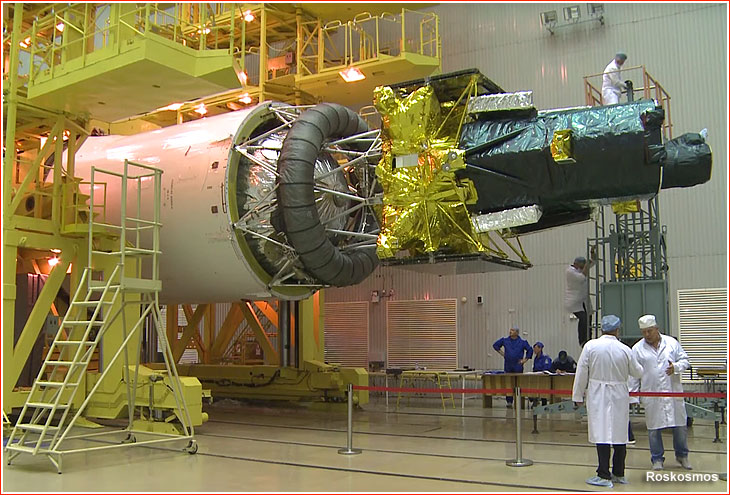
The payload section of the Spektr-RG mission.
At the time of separation of the third and fourth stages, both vehicles were supposed to be on a ballistic trajectory, just short of orbital velocity and reaching its peak at an altitude of 200.4 kilometers and an inclination 51.51 degrees toward the Equator. With its engine shut down and most of its propellant expended, the third stage then reentered the atmosphere and any of its surviving debris fell into the Pacific Ocean, east of Japan.
In the meantime, after nearly six minutes in a ballistic flight, or 15 minutes 44 seconds after liftoff, the Block DM-03 upper stage fired its main engine. The maneuver lasted 3 minutes 11 seconds, giving the vehicle 695.93 meters per second in additional velocity. It inserted the space tug and its payload into a 170 by 1,927.7-kilometer Earth's orbit with an inclination 51.49 degrees. At this altitude it would take the spacecraft 1 hour 46 minutes 9 seconds to make one full revolution around the Earth. However, during the Spektr-RG mission, the stack flew passively around the planet for only 1.3 hours before the next propulsion phase was scheduled to begin.
The main engine of Block DM-03 re-started at T+1 hour 37 minutes in flight and kept firing for 9 minutes 27 seconds.
The maneuver was designed to accelerate the vehicle by 3,957.32 meters per second and place it on a 500 by 1,293,041-kilometer orbit with an inclination 51.6 degrees toward the Equator, effectively taking the spacecraft into deep space.
According to the plan, the entire process of the insertion into the Earth's escape trajectory took 1 hour 59 minutes 55 seconds and concluded with the separation of the Spektr-RG spacecraft from its upper stage 13 minutes after the completion of the second maneuver.
The separation of the observatory from the stage was designed to take place within communications range of the Russian ground stations assigned to control the Spektr-RG mission, industry sources said. The NIP-14 ground station at Medvezhi Ozera, near the town of Shelkovo, on the eastern outskirts of Moscow, was expected to play a role of the main nerve center for the mission.
Around 1.16 hours after the separation of Spektr-RG, the Block DM-03 stage should maneuver to a safe orbit away from the spacecraft, firing its engine twice for 300 and 260 seconds.
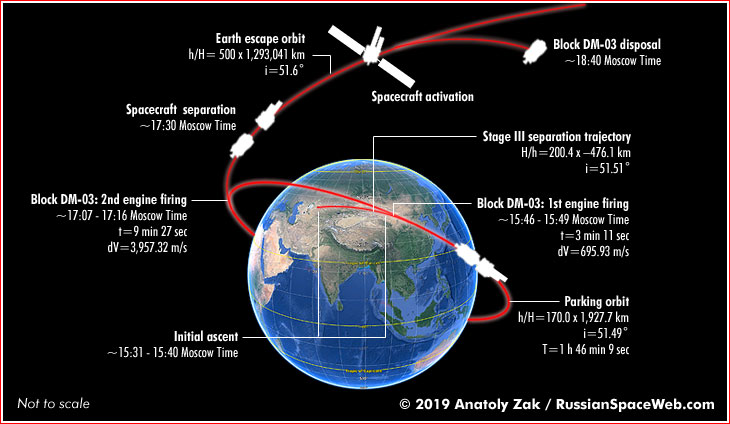
Spacecraft activation
The first telemetry link between the spacecraft, flying autonomously toward the Lagrange point, and the ground was expected at 17:38 Moscow Time (10:38 a.m. EDT) to begin informing controllers about onboard operations. A pair of solar panels aboard the Navigator service module were scheduled to deploy at 19:28 Moscow Time (12:28 p.m. EDT).
Between 19:38 and 19:58 Moscow Time (12:38 - 19:58 p.m. EDT), mission control was expected to activate the eROSITA telescope aboard the spacecraft.
As the spacecraft drifted away from Earth, the first communications window between Spektr-RG and its ground station were expected to close around 21:24 Moscow Time (1:24 p.m. EDT). Because the high-power transmitter aboard the spacecraft put considerable pressure on the operation of the observatory's thermal control system, communications with Spektr-RG were limited to just four hours per day.
Following the activation of Spektr-RG on the day of the launch, the spacecraft was to spend the next three months sailing toward a region 1.5 million kilometers behind the Earth relative to the Sun, toward one of five so-called Lagrange points where gravitational forces between the two bodies reach an equilibrium. It will then circle the L2 point scanning the sky with its German-built eROSITA and Russian ART-XC telescopes to map the Universe in X-ray light.

Estimated ground track of the Spektr-RG mission.
Several minutes after the planned separation of the Spektr-RG from the Block DM-03 upper stage, Roskosmos confirmed that the spacecraft had been functioning well and its solar panels had deployed. The eROSITA team in Germany also confirmed that the spacecraft had found the Sun and the initial data from the German instrument had showed good temperature, thanks to the telescope's Interface and Thermal Controller, ITC, which had been successfully activated.
Russian ground tracking cameras found the spacecraft on a close-to-predicted trajectory and also imaged the pressurized contents venting from its Block DM-03 stage in a process known as "passivation." It was designed to prevent possible explosion of the tanks as a result of their heating by the Sun.
Planned orbital parameters at the separation of the Spektr-RG satellite from the Block DM-03 upper stage on July 13, 2019, according to GKNPTs Khrunichev:
| Perigee | 498.8 kilometers* |
|---|---|
| Apogee | 1,299,305.5 kilometers* |
| Inclination | 51.68 degrees |
| Perigee latitude argument | 3.912 degrees |
| Longitude of the ascending node | 127.824 degrees |
*For radius of the Earth equal 6,378 kilometers
Next chapter: Spektr-RG cruises toward Lagrange point (INSIDER CONTENT)
Article and illustrations by Anatoly Zak; Last update:January 31, 2024
Page editor: Alain Chabot; Edits: July 12, July 16, 2019
All rights reserved
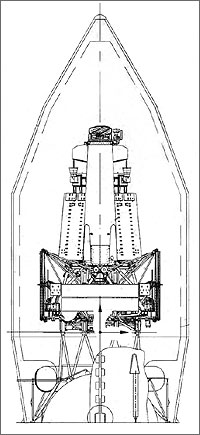

Block DM-03 with the Spektr-RG observatory is being prepared for launch on June 5, 2019. Click to enlarge. Credit: Roskosmos
Click to enlarge. Credit: Dmitry Rogozin
Proton with Spektr-RG returns to the launch pad on July 9, 2019. Click to enlarge. Credit: Roskosmos
Service gantry moves into position around the Proton rocket with Spektr-RG satellite, after its return to the launch pad on July 9, 2019. Click to enlarge. Credit: Roskosmos
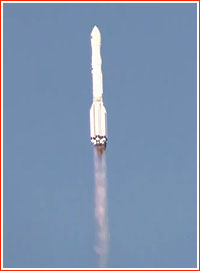
Proton with Spektr-RG lifts off on July 13, 2019. Credit: Roskosmos
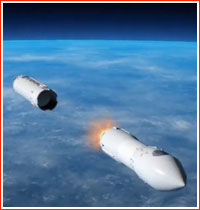
Artist rendering of the separation between second and third stages of the Proton rocket during the delivery of the Spektr-RG observatory into initial Earth's orbit. Credit: Roskosmos
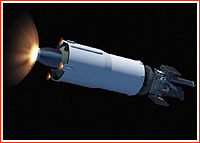
Artist rendering of the third stage firing during the delivery of the Spektr-RG observatory. Credit: Roskosmos
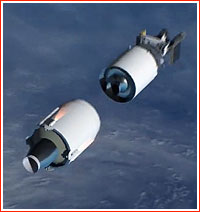
Artist rendering of the third stage separation during the delivery of the Spektr-RG observatory. Credit: Roskosmos
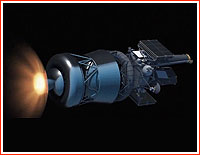
Artist rendering of the Block DM-03 firing during the delivery of the Spektr-RG observatory. Credit: Roskosmos
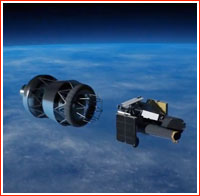
Artist rendering of the separation between the Block DM-03 stage and the Spektr-RG spacecraft. Credit: Roskosmos

)
)
)
)
)
)